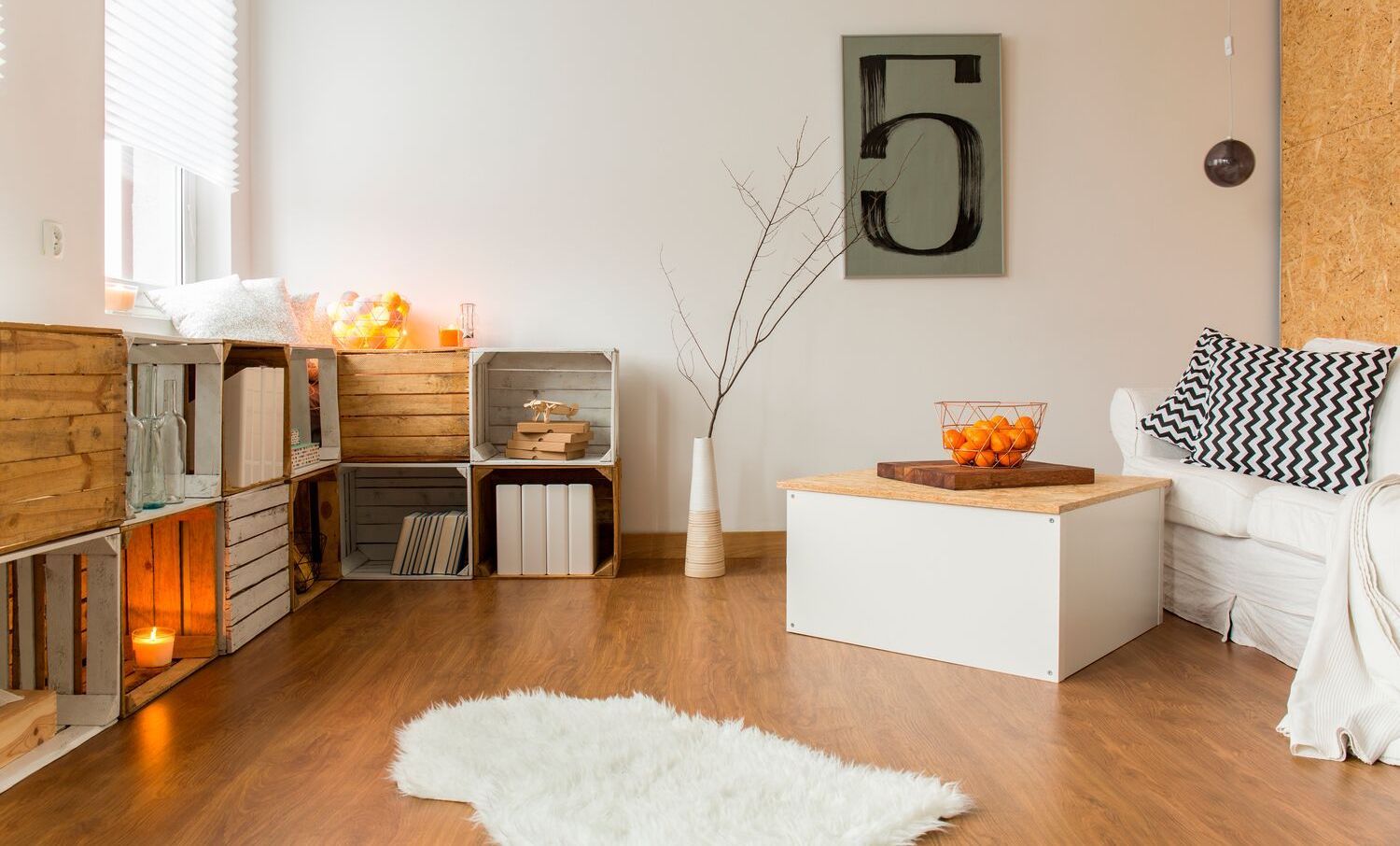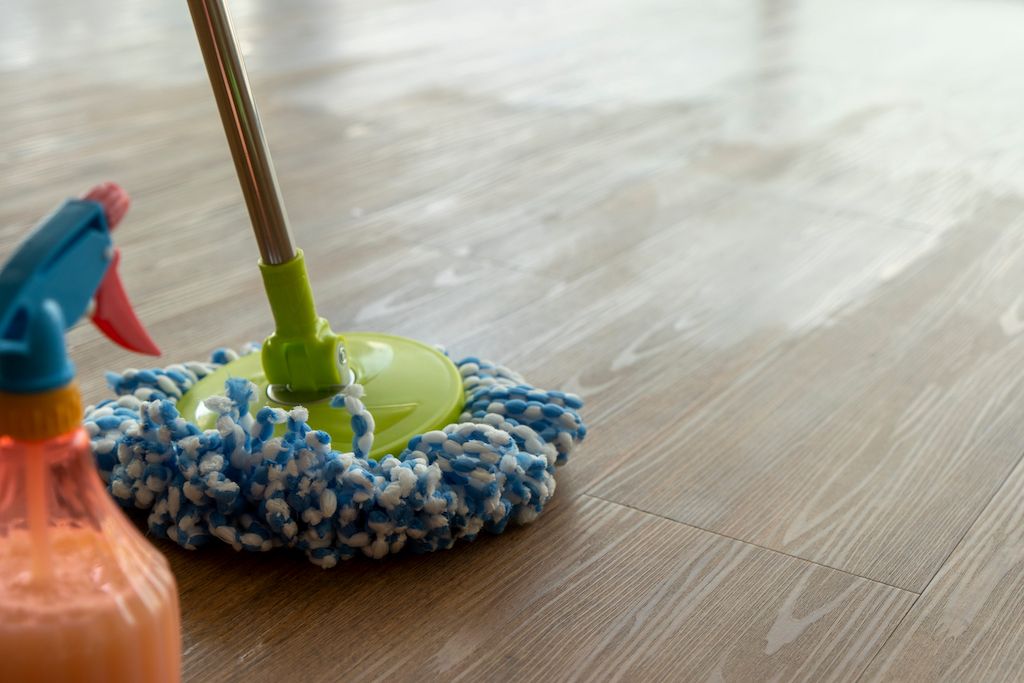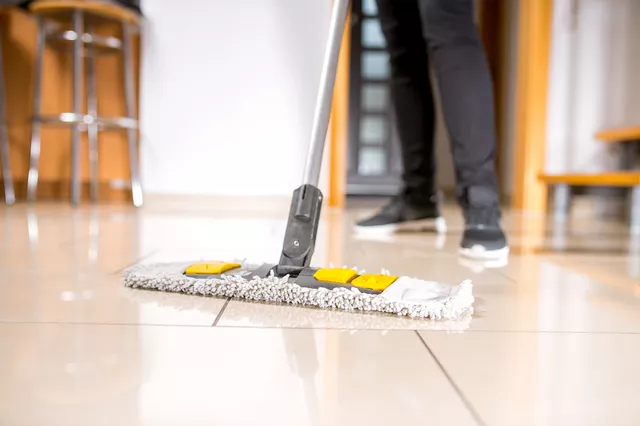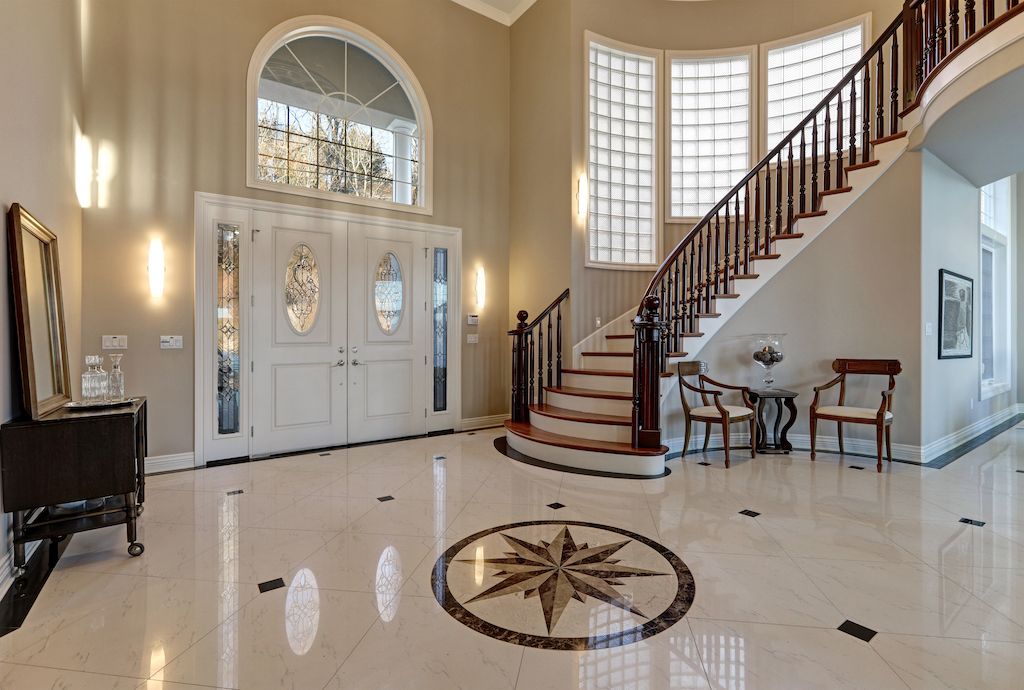How often should you mop a floor?
You should mop your floor as often as you see fit — usually every few weeks or once a month for low-traffic areas. For high-traffic areas (think: kitchen, entryways, etc.), you may need to mop once a week.
Areas to mop at least once a week | Areas to mop once a month |
- Bathrooms
- Bedroom
- Dining area
- Entryway
- Family room
- Hallway
- Kitchen
| - Guest room
- Laundry room
- Office or den
|
Pro tip: You should be sweeping and/or vacuuming your floors more often than mopping them. In fact, you should sweep or vacuum your floor before you begin mopping. It’s important to pick up loose dirt to avoid spreading it around while mopping your floors.
Which mop should you use?
Before you begin, make sure you have the right equipment — starting with your mop. You have many to choose from, including:
Mop type | Pros | Cons |
Dust mop | Can be used for daily, light cleaning on floors and other surfaces (ceiling, walls, etc.) | Not recommended for heavy-duty cleaning or wet mopping |
Flat mop | Good at getting into corners and often have reusable cloths | Not great at scrubbing off hard-to-remove dirt and grime |
Sponge mop | Great for absorbing spills and scrubbing | May dirty up your tile grout and leave behind streak marks |
Steam mop | Thorough cleaning and disinfecting high-traffic area | Can be pricey, and not recommended for real wood or laminate floors |
String mop | Budget-friendly and good at getting into corners | Requires a bucket to wring out the water |
What else do you need to mop your floors?
In addition to your mop, make sure you also have:
- Vacuum cleaner or broom (to pick up loose dirt before you start mopping)
- 2 buckets: one for your cleaning solution and one to rinse your mop after a couple of passes
- Cleaning solution (either homemade or store-bought) approved by your manufacturer
- Rags or soft cloths (to help dry your floors)
How to mop a floor, step-by-step.
When mopping floors, there are some things to keep in mind depending on the type of floor you have. But first, here are some general steps that apply to all floor types:
- Grab your mop, buckets and cleaning solution. Decide what type of mop you want to use, and choose the best cleaning solution for your floor type (more on that below).
- Vacuum or sweep your floors. Remember: Get all of the food, dust, dirt and grime off your floors to avoid causing a bigger mess (or worse, damage to your floors).
- Plan your exit and begin. Start mopping away from the room’s exit and work your way back. This will help you avoid stepping on wet spots and dirtying up your floors with your shoes.
- Follow the grain. When mopping wood floors, mop in the direction of the grain. Use the figure 8 motion if you’re using a string or rag mop.
- Wring out excess water. For most flooring types, too much water is a bad thing because it can ruin your floors (especially hardwood and laminate floors).
- Get low and bring out your sponge. For those stubborn, hard-to-remove spots or stains, go over the area again. Be prepared to get on your hands and knees and scrub.
- Let it dry. Air dry your floor or use a soft, lint-free cloth.
- Clean your mop and bucket. Keep your supplies clean by rinsing out your bucket and mop. Avoid bacteria growth by cleaning these items with a mixture of bleach and water.
Now, let’s get into the nitty gritty. From how much water to use to the type of mop you choose, make sure you follow these tips when cleaning your hardwood, tile, laminate, vinyl and concrete floors.
Get a free estimate from a great floor cleaner near you.
Please enter a valid zip code
How to clean hardwood floors.

Hardwood floors are beautiful, durable and timeless. Wood floors are generally engineered or solid, with common hardwood species including oak, pine, cherry, walnut, hickory and maple.
The following mopping and vacuuming tips can help ensure that you can keep your floors clean and protected over time (regardless of the wood type). Check with your hardwood floor’s manufacturer to find out what cleaning solution you should use on your floors.
Some good rules of thumb:
- Sweep or dust mop frequently. Purchase a high-quality broom and commit to sweeping your hardwood floors once a day. This will help cut down on grime.
- Vacuum once a week. Use a vacuum without a beater bar to suck up any debris that falls between the wood slats.
- Use a terry cloth mop monthly when cleaning your “finish in place” wood floors. Keep in mind that unique hardwood flooring might require specific cleaning tools and products.
- Wipe up spills immediately. This is especially important when stains and sticky spots occur. The longer you leave spills on your wood floors, the greater chance of permanent staining and damage.
Best cleaners for hardwood floors.
If you have real hardwood floors, use a cleaning solution that’s recommended by your manufacturer or a floor cleaning professional. Often, the type of finish you have will determine what you can use on your floors. For example:
- Polyurethane finish. Opt for a little bit of warm water and a pH-neutral soap. You may be able to use white vinegar and warm water to treat stains.
- Urethane finish. Use a water-based cleaner. Vinegar may damage this finish.
- Wax finish. Use a solvent-based cleaner and liquid wax. Avoid using too much water.
Maintenance tips for hardwood.
In addition to regularly cleaning your wood floors, use these tips to protect your floors from fading, moisture, scratches, dents and other damage:
- Use rugs and mats. Add rugs and mats to high-traffic areas and spots where water damage might occur. For example, if you have hardwood flooring by your front door, a rug can help protect the floor from being scuffed up by rocks and other debris. Additionally, if you have wood floors by a sink, a mat will help keep them dry.
- Control the humidity. Remember: wood flooring can warp and swell during the summer months. Keep your home between 60-80 degrees and 30-50% humidity throughout the year, recommends the National Wood Flooring Association.
- Protect your floors from furniture. Cover furniture feet with felt or another soft material to prevent scratching.
- Add window treatments. Prevent sun damage by blocking UV ray exposure that causes fading.
- Recoat. If your hardwood floors look dull, recoating can bring them back to life.
- Refinish. Sometimes, recoating isn’t enough — especially if you have severe scratches and dents. Instead, you might need to sand and refinish your hardwood floors. If you have engineered hardwood floors, however, you might not be able to refinish them as often as solid wood floors. When in doubt, ask an expert.
Related: How much does hardwood floor refinishing cost?
Mistakes to avoid when cleaning hardwood floors.
- Don’t use a cleaning solution that leaves behind a residue.
- Never use an all-purpose or multi-surface cleaning product. Opt for a product specifically designed for your hardwood flooring type.
- Never overdo it with water. Use a damp mop with warm water, not a sopping one. If the mop is absorbing too much water, wring it out thoroughly.
- Never use cleaners that contain ammonia.
- Never use oil soaps.
- Never use steam mops.
When to hire a hardwood flooring professional.
Here are a few situations where you should consider hiring a flooring professional to handle repairs and other hardwood flooring projects:
- There’s water damage.
- You see deep scratches.
- Your wood floors are fading.
- You can’t remove a permanent stain.
- You’re thinking about recoating or refinishing your hardwood floors.
Compare prices from floor cleaners near you.
Please enter a valid zip code
How to clean laminate floors.
 Because of their affordability and durability, laminate floors are becoming increasingly popular. They’re an economical choice that offers extreme durability. For homeowners who have laminate floors, the following cleaning and maintenance tips will help ensure your laminate floors’ longevity.
Because of their affordability and durability, laminate floors are becoming increasingly popular. They’re an economical choice that offers extreme durability. For homeowners who have laminate floors, the following cleaning and maintenance tips will help ensure your laminate floors’ longevity.
As with any home maintenance project, read your manufacturer’s guidelines to find any special instructions on how to properly mop and clean your laminate floors. If you can’t access the guide, here are some cleaning tips from the World Floor Covering Association:
- Start by sweeping your laminate floors. Regular sweeping can cut down on the damage that abrasive dirt can cause to your laminate’s surface. Try to sweep at least once a day.
- Use a vacuum without a beater brush to reach debris that has fallen into cracks, corners or other hard-to-reach areas.
- Use a damp mop. Never use a large amount of water on laminate as it can cause it to expand and crack. Always wring out your mop first.
Related: What is laminate flooring?
Best cleaners for laminate floors.
Read your manufacturer's guide to see what products they recommend for your laminate floors. If you can’t access the guidelines, then choose a product specifically designed for laminate floors. Just make sure it’s not an oil-based cleaner, which can leave behind an ugly film and streaks. Also, don’t use a cleaner that contains wax or polish.
If you prefer to use a DIY floor cleaner, you can use vinegar and water.
Maintenance tips for laminate.
- Add rugs and mats to high-traffic areas. Doorways, kitchens and hallways are all great locations to put down a rug for extra protection.
- Be careful with water. If you have laminate flooring in a kitchen or bathroom, be sure to protect the floor and keep it dry.
- Utilize glides and floor protectors. Prevent scratching, and when moving furniture, lift — don’t drag.
Mistakes to avoid when cleaning laminate floors.
- Never use a cleaner that requires an excessive amount of liquid.
- Never use a cleaner that uses steam.
- Never apply cleaner directly to your laminate floors.
- Never use oil-based cleaners.
- Never sand or refinish your laminate floors.
- Never use abrasive cleaners or cleaners with wax or polish.
- Never use steel wool.
- Never use a scouring powder.
- Never use wax or a product that “leaves a protective coating.” Your floors may turn gray or yellow.
Related: Laminate vs. vinyl flooring comparison guide.
When to hire a laminate flooring professional.
When you notice any of the following signs of damage, contact a professional for repairs or replacement:
- Cracking or bulging due to water damage
- Faded areas
- Deep scratches or dents
- A dull appearance that is not solved through regular cleaning
Find the right floor cleaner for your project.
Please enter a valid zip code
How to clean vinyl floors.
 Another popular choice for those seeking an economical alternative to wood and stone, vinyl floors come in a variety of styles and designs. Modern vinyl flooring is designed to be waterproof, making it a great option for bathrooms and kitchens. Available in large sheets, vinyl flooring also offers durability.
Another popular choice for those seeking an economical alternative to wood and stone, vinyl floors come in a variety of styles and designs. Modern vinyl flooring is designed to be waterproof, making it a great option for bathrooms and kitchens. Available in large sheets, vinyl flooring also offers durability.
The good news is that keeping vinyl flooring clean is relatively easy. The following cleaning and maintenance tips will help ensure your vinyl floors remain beautiful over the years.
- Sweep and vacuum daily. Vinyl may be durable, but sand, dirt and grit are still threats to its surface.
- Utilize warm water to clean the surface of your vinyl floors.
- Use a soft mop, such as one made from microfiber, rather than an abrasive scrub brush. Rinse with clean water.
Related: Installing vinyl floors? Here's what you need to know.
Best cleaners for vinyl floors.
When it comes to vinyl floor cleaning products, always follow the manufacturer recommendations. However, most vinyl flooring can hold up to “no-rinse” cleaners, according to the WFCA. You can also use an apple cider vinegar and water solution.
Maintenance tips for vinyl flooring.
Vinyl flooring is extremely low maintenance and holds up well against water and foot traffic. But it may be even longer if you follow these maintenance tips:
- Clean up spots and spills as they occur.
- Place your mats and rugs near doors, but avoid rubber-backed mats that might leave a stain or mark.
- Use floor protectors on your furniture to avoid scratching your vinyl floors.
- Wipe up spills quickly to avoid permanent stains and moisture damage.
Mistakes to avoid when cleaning vinyl floors.
- Never use abrasive cleaners or harsh chemicals.
- Never use rough scrub pads or scrub brushes.
- Never use mop-and-shine products that will leave behind a residue or film.
- Never use paste wax polishes.
- Never use a vacuum with a beater bar attachment.
- Never use a large amount of water. If you do, it will destroy the glue bond and your flooring’s edges might lift. You may also start to see bubbles.
When to hire a vinyl flooring professional.
If you notice a seam on your flooring that’s opening up or a gouge in the vinyl, contact a flooring specialist for repairs. You should also contact a professional if there’s excessive water damage and the edges are curled.
For homeowners and renters who don’t have the time to keep up with cleaning floors as frequently as needed, hiring a professional from time to time is a great way to protect flooring from long-term damage.
Search local floor cleaners and check prices.
Please enter a valid zip code
How to clean tile floors.
 Often found in bathrooms and kitchens, tile is a great choice for moist or wet areas. People love tile because it comes in many designs, styles and materials, including ceramic, porcelain, marble, granite, limestone, mosaic and more.
Often found in bathrooms and kitchens, tile is a great choice for moist or wet areas. People love tile because it comes in many designs, styles and materials, including ceramic, porcelain, marble, granite, limestone, mosaic and more.
Taking proper care of your tile is key to ensuring that you enjoy it for many years to come. Because there are so many different types of tiles, always look for cleaning instructions in the manufacturer’s guidelines.
Here are some mopping and cleaning tips for your tile floors:
- Sweep or vacuum. Be sure that your vacuum does not have a beater bar, as this can scratch your tile. Sweeping and vacuuming will allow you to quickly remove any loose debris from your tile flooring. You can also use a dust mop.
- Mop your tile floors. Once you’ve cleared debris, use a soft, damp mop with a manufacturer-recommended tile and grout cleaner. You may also be able to use a neutral pH cleaner on tile floors made out of natural stone.
- Deep clean the tile as grime builds up. Utilize a soft brush and an all-purpose cleaner or mild detergent. Gently scrub the textured tile and grout to remove the dirt. Once complete, rinse thoroughly and dry completely.
- To clean grout, use a stiff brush. After applying an approved cleaner, vacuum up the dirty water.
Best cleaners for tile floors.
There are many products you can buy for your tile floors, including all-purpose cleaners and pH-neutral soaps. Just make sure they adhere to your manufacturer’s guidelines. Some DIY cleaning solutions for your tile (and grout) also include:
- All-purpose cleaner or mild detergent with warm water
- White vinegar and warm water
- Baking soda and warm water
- Baking soda, hydrogen peroxide and dish soap
Related: How much does professional grout cleaning cost?
Maintenance tips for tile.
- Clean up any spills right away. Leaving a spill for too long can permanently stain the tile, particularly the grout.
- While tile is sturdy, be careful when moving heavy objects. Always use furniture protectors on tile and avoid dragging heavy objects across the surface.
- Use non-slip mats or area rugs to protect your tile floors.
- Ask a professional about sealing your tile flooring. If water and moisture can permeate the tile, damage can occur.
Mistakes to avoid when cleaning tile floors.
- Never mix bleach and ammonia.
- Never use an acid-based cleaner.
- Never use steel wool or scouring powders.
- Never use abrasive cleaners such as dry cleansers or soft cleansers on a natural stone tile.
- Never use vinegar, lemon juice, or other cleaners containing acids on marble, limestone, travertine or onyx surfaces.
When to hire a tile flooring professional.
Here are a few signs that indicate you should hire a tile flooring professional:
- Uneven tiles
- Discolored or stained tiles
- Grout is chipped or deteriorating
- Chipped, cracked or missing tiles
- It’s time to reseal your tile (check your manufacturer’s guidelines)
While tile is a durable and beautiful choice for flooring, tile flooring does need to be cleaned frequently to ensure that the surface is not damaged. For busy homeowners, a regular floor cleaning service can help maintain the lifespan of their tile floors.
See which floor cleaners are top-rated in your area.
Please enter a valid zip code
How to clean concrete floors.
 There is perhaps no flooring type more durable than concrete. Gone are the days of concrete being solely outdoor material. A popular option for basements, modern concrete floors are designed to be beautiful, modern and easy to maintain.
There is perhaps no flooring type more durable than concrete. Gone are the days of concrete being solely outdoor material. A popular option for basements, modern concrete floors are designed to be beautiful, modern and easy to maintain.
Keep these tips in mind when cleaning your concrete floors:
- Begin by sweeping, vacuuming or dust mopping. Regularly clearing away debris and dust is a great way to help protect the surface of your concrete floors.
- Next, it’s time to mop. Concrete floors can withstand water, which makes them relatively easy to mop. Utilize a mild detergent with warm water.
- Thoroughly rinse and dry your concrete floors after you’re done mopping.
Related: How much does concrete cost?
Best cleaners for concrete flooring.
The best cleaners for concrete flooring are the products and solutions recommended in your owner’s manual. When in doubt, opt for pH-neutral cleaner.
Maintenance tips for concrete floors.
Concrete is a relatively easy flooring material to maintain. Use these tips to prevent cracks and preserve its polish.
- Dust frequently to prevent scratches and damage.
- Address spills and stains immediately to prevent permanent damage.
- Get it sealed to stop water from penetrating it and prevent stains. If you have polished concrete, it doesn’t need to be resealed.
- Read your manufacturer's guide to find out how often you should seal your concrete. Typically, it’s recommended you reseal every few years.
- Consider applying wax on top of your sealer, but keep in mind that polished concrete doesn’t require wax.
- Fix any cracks. If not, dirt will get trapped.
- Use floor mats or rugs to prevent dirt.
Mistakes to avoid when cleaning concrete floors.
- Never use harsh cleaners (ammonia, bleach, vinegar, etc.). These can damage the concrete’s sealant.
- Never use a metal wire brush on concrete flooring.
- Avoid using muriatic acid to clean concrete, specifically if you want to stain it in the future.
When to hire a concrete flooring professional.
Whether you need help cleaning, sealing or repairing your concrete floors, contact a local professional if you notice that:
- Your concrete flooring is cracked, chipped or deeply scratched.
- Your concrete needs to be sealed or resealed.
- You want to stain, stamp, polish or wax your concrete floors.
- You want to install new concrete floors in your home.
Find the best floor cleaner in your neighborhood.
Please enter a valid zip code
How to clean marble floors.
 There might not be a flooring type more luxurious than marble. This beautiful, natural stone is elegant and timeless. Keeping your marble floors clean and well maintained is a must to ensure you enjoy the longest lifespan possible with the least amount of repairs needed.
There might not be a flooring type more luxurious than marble. This beautiful, natural stone is elegant and timeless. Keeping your marble floors clean and well maintained is a must to ensure you enjoy the longest lifespan possible with the least amount of repairs needed.
The following cleaning tips will help keep your marble sparkling:
- Marble floors should be cleaned frequently with a dust mop. The frequency depends on how many people and pets are living in your home. Estimate cleaning once a week for one person in the home, twice a week for two, and so on.
- Only use a soft microfiber cloth on marble floors. Never use scrubbing brushes.
- When cleaning with a product, use a pH-neutral product. This will reduce streaking and residue buildup.
- Always dry your marble after washing. This ensures that iron oxide in the water does not leave behind rust stains.
- Use a poultice to remove stains from your marble.
Maintenance tips for marble flooring.
- If you spill, blot it immediately. Leaving spills on your marble floor can lead to permanent staining and etches.
- Use the right cleaners to prevent etching. Check your manufacturer’s guide for a list of cleaning products you can use.
- Know the difference between stains and etches, so you use the right cleaners. Stains have spots that are darker than the surrounding stone; etches are spots that are lighter than the stone.
- Consider sealing your marble to make it resistant to stains and moisture.
Mistakes to avoid when cleaning marble floors.
- Never use products with acids, such as lemon juice or vinegar.
- Never utilize harsh cleaning products on marble floors.
- Never use scouring powders.
When to hire a marble flooring professional.
If any of the following scenarios apply to you, talk to a flooring professional about cleaning, repairing, sealing or replacing your marble floors:
- You see etch marks.
- You have permanent stains.
- Your marble floors have cracks, chips or deep scratches.
- It’s time to seal/reseal your marble floors.
Get free estimates from top-rated floor cleaners.
Please enter a valid zip code
Use Thumbtack to find flooring professionals.
Whether you need to clean your laminate floors, refinish hardwood, seal your concrete or make some repairs, Thumbtack can help. Find a local flooring company or contractor who can inspect your floor’s condition, clean it or repair it immediately. After all, taking good care of your floors is key to keeping a comfortable and clean home — and to protecting your investment.
FAQs
What is the best thing to clean floors with?
Here are the answers to some of the most common questions people have about mopping and maintaining their floors:
It’s always best to use a cleaning solution that’s recommended by your flooring’s manufacturer. If you want to take the DIY route, remember these guidelines:
- Hardwood: Choose a pH-neutral cleaner and warm water. Go easy on the white vinegar, which may damage your finish. Avoid too much water.
- Laminate: You can use vinegar and water. Again, don’t overdo it with the water.
- Tile: You can try white vinegar and warm water; baking soda and warm water; or baking soda, hydrogen peroxide and dish soap.
- Concrete and marble: Go with a pH-neutral cleaner with warm water. Avoid citrus, vinegar, bleach and ammonia.
Is vinegar a good floor cleaner?
Yes, vinegar can be a good floor cleaner for tile and laminate. However, be cautious when using vinegar on wood floors. Due to vinegar’s acidity, you’ll need to dilute it with water to avoid damaging your hardwood floors. And avoid using it on concrete and natural stone (eg., marble) flooring.
How do you deep clean floors?
The deep cleaning for floors depends on the material. Essentially, you’ll follow all of the steps above but focus on getting out those tough stains. If you use a flat mop with a removable pad, you’ll likely need to use several pads. If you’re not up to the task, consider hiring a professional cleaner for the job.
Find a top-rated floor cleaner near you.
Please enter a valid zip code
What is the easiest way to clean floors?
The easiest (and best) way to clean your floors is hire a professional to do it for you.
But if that’s not a possibility, always remember these tips:
- Wringing out and rinsing traditional string mops can be tough and tedious. Flat, sponge and steam mops are often easier to use.
- Vacuum and dust regularly — daily, if possible. It’ll make mopping easier.
- Practice good floor maintenance habits (wipe up spills ASAP, utilize rugs and mats, etc.)
- Mop your high-traffic areas once a month.
Why is my floor still dirty after mopping?
There could be a couple of reasons why your floor is still dirty after mopping. For example, you may have left behind dirty, soapy water on your floors. Another culprit: the cleaning product you chose. If you used a product that contains oil or wax, it might leave behind a residue.
Keep your floors clean after mopping them by:
- Placing rugs and mats in high-traffic areas
- Reducing the amount of foot traffic that goes through the room
- Dust your home regularly and clean your HVAC filters
- Close your windows and doors
How do you clean a floor without a mop?
If you don’t mind getting your hands and knees dirty (literally), you can always use a sponge to clean your floors. Just dip it into a bucket with your cleaning solution, and get to scrubbing. Also, consider using a microfiber cloth, broom and vacuum.
Additional sources: Bob Villa, Concrete Network, National Wood Flooring Association, Natural Stone Institute, North American Laminate Flooring Association, The Spruce, World Floor Covering Association
 Because of
Because of  Often found in bathrooms and kitchens, tile is a great choice for moist or wet areas. People love tile because it comes in many designs, styles and materials, including ceramic, porcelain, marble, granite, limestone, mosaic and more.
Often found in bathrooms and kitchens, tile is a great choice for moist or wet areas. People love tile because it comes in many designs, styles and materials, including ceramic, porcelain, marble, granite, limestone, mosaic and more.